Chain tensioner added to first reduction. Works beautifully.
I need to make a mounting plate so I can attach this temperature-controlled blower fan as shown.
It handles really well. I'm actually surprised by how comfortable it is.
Spacer plate for the blower fan.
Blower fan installed. Does a fine job of keeping the motor at reasonable temperature levels.
I ended up making a chain pad since I couldn't find a replacement one anywhere.
Rode it 5 miles today. Performs really well.
Next step is to replace the battery pack and controller wiring with a higher wire gauge so I can remove the circuit breaker (or get one with a higher rating).
John H.Founder of Current Motor Company - opinions on this site belong to me; not to my employer Remember: " 'lectric for local. diesel for distance" - JTH, Amp Bros || "No Gas.
Here's everything I've done in the past month. I apologize for not being able to take in-progress shots, but my camera took an accidental vacation in China because my boss mistook it for his.
+ I bought a 5/8" ID steel freewheel adapter from Staton Inc.,
+ I used the lathe to bore the ID out to match the motor axle size.
+ The #40 double-D-bore sprocket included with the motor was ground down to make a washer.
+ Washer was then TIG welded onto the freewheel adapter.
+ I drilled the hole pattern into the #35 sprockets, then used a bolt to chuck in the lathe so I could cut out the large center hole.
+ I made a motor-mount plate out of 1/4" polycarbonate, and end brackets out of 1" aluminum square tube.
The sprockets are bolted onto the opposite sides freewheels so I could attach the motors to the motor mount plate at an offset. This allowed me to overlap the gear case of the top motor over the cover of the lower motor.
See below image showing where I had to grind both.
Doing this save me just enough space so that I had more than enough clearance between the frame and the top side of the chain.
I also drilled out and cut square notches in the mounting holes.
I thought I was going to have to offset the brushes 90 degrees to reverse the motors, but it turns out the motors spin the right way around when stock.
Wasted effort on my part, but at least I had the option of reversing them later on.
Left to do
1. Make new aluminum foot pegs. The polycarbonate ones broke when the bike was accidentally tipped over.
2. Make new brake light
3. Make new turn signals (front and back)
4. Record a video for everyone that has been nagging me to
It seems that your energy calculations are incorrect, since one horsepower is 746 watts, a 1.8 horspower requirement means that if the motor were 100% efficient(they are not) a D.C. power of 1,342.8 watts, not 1,000 watts as stated, would be needed to provide this power. (In reality, considering losses in the controller, wiring, and moter efficiency,(mostly lost as heat) actual D.C. power needed to produce 1.8 horsepower of usable enegy is likely to be much closer to 1,700 watts!-Batteries and wiring will need to be sized to handle this, as well as momentary overloads of perhaps 3 times this, when accelerating. Some battery cells do not last as long if not operated in the upright mounting condition, perhaps you may want to check with the manufacturer of your cells, as it seems they would be almost lying on their sides?--Bob
1,000 watts is the constant rating of the previous motor. I was reaching 2,500 watts during acceleration, which the motor was unable to survive. I haven't done any calculations, because I don't have a finished build.
I've already contacted the manufacturer of these batteries and they said that these batteries will work fine in any orientation other than being upside-down. Mounting them sideways will only shorten their life a marginal amount (less than 10%).
What happened? When did the single motor get changed to dual motor?
I know the old motor was overheating, then the blower fan active cooling was added...with mediocre results.
Then suddenly the photos show dual motors. How are you connecting the controller to the dual motors?
BTW, usually overheating motors indicate the transmission is geared too high (I assume the motor is not undersized). Perhaps regearing will help?
What happened? When did the single motor get changed to dual motor?
I know the old motor was overheating, then the blower fan active cooling was added...with mediocre results.
Then suddenly the photos show dual motors. How are you connecting the controller to the dual motors?
BTW, usually overheating motors indicate the transmission is geared too high (I assume the motor is not undersized). Perhaps regearing will help?
The single 1kw motor couldn't survive the 2.5kw peak current draw that was required under acceleration on level ground. I'm switching to a pair of 600watt gear-head motors so that the current load can be divided between them. They won't overheat since they're not individually being overcurrented as much as a single motor would be. This setup will also give me greater low-end torque.
Brushed motors can easily be wired to a controller in parallel.
I've found a solution for linking them together with chain to fix the slipping issue and will be implementing it on Monday.
The batteries are back in and it's running. I'll record a video sometime soon (have to figure out a camera mount first).
It has A LOT of low-end torque. Climbs hills easily even at 25% throttle.
The motor, gear, and chain drive combination sounds very spacey.
Absolutely amazing project! Congratulations!
Will it be street legal?
Yes, but will be considered equivalent to a moped according to the DMV code in my state.
Went for a test drive this afternoon. Top speed on level ground is 38MPH.
Not sure what the range is going to be.
I need to add a stronger spring to the drive chain tensioner before I ride it any further.
Great work ! A French off-road bikes manufacturer is making a similar concept.
Scorpa is known by their trial bikes. They have designed a light moped for road use that is easily convertible to a trial bike. It is more expensive 2600€, but are using good parts (specially the battery):
1000W DC 48V Brushless motor and a 16Ah removable Li-Po battery (you can optionally use 2 packs in parallel)
Here it is: eTricks
Upgraded to much heavier springs on the chain tensioners.
I'm going to install a temperature monitor on one of the motors before I do any further testing. Neither of them were getting anywhere near as hot as the previous motor, but I still want to be able to monitor them.
I'm also probably going to add a fan to the chain guard I will hopefully be making by this weekend.
Bad News, and I need a break from this project.
The lower freewheel is destroyed.
I'm going to have to rethink the drive system a little bit. Probably by switching to having just one freewheel, and using static sprockets to link the two motors.
Ouch!
this chain hurts... In my opinion this transmission is too complex..
Two small engines... Are they powerful enough? I'm afraid they aren't.
On the other hand you are wasting too much energy in these chains and gears. Electric power is not meant for this complexity, it allows simplicity...
I suggest you to have a look at the bikes from ttxgp:
The engine was directly linked to the rear sprocket. One permanent gear, 70 km/h speed; Superb climbing capacity. No need of any kind of freewheel gear.
Ouch!
this chain hurts... In my opinion this transmission is too complex..
Two small engines... Are they powerful enough? I'm afraid they aren't.
On the other hand you are wasting too much energy in these chains and gears. Electric power is not meant for this complexity, it allows simplicity...
I suggest you to have a look at the bikes from ttxgp:
While I agree with some of what R says - along the lines of "are two motors better than one?" I very much disagree with his suggestion that you simply copy what else has already been done many times by many people. I applaud your effort and obvious engineering and fabrication skill going into this project. By trying the non-obvious and solving the problems and sharing your efforts in this way you're doing the community a great service. I bet you're having fun along the way.
Keep up the good work! :-)
John H.Founder of Current Motor Company - opinions on this site belong to me; not to my employer Remember: " 'lectric for local. diesel for distance" - JTH, Amp Bros || "No Gas.
you are wasting too much energy in these chains and gears.
Mmmm maybe I'm not comunicating properly.. I'm talking in terms of energy efficiency, not in terms of personal effort. These complex chains absorb a nice percentage of the battery that simply heats nothing else than metal jointures. I encorauge creativity, of course, but joined with efficiency. There's so few energy inside a battery! EV can't waste it like an oil burner... Sure no need to copy, let's innovate and try to build these two engines mixed into one and inside the wheel... no gears, no transmission... ;-)
Drilled and tapped the small sprockets to M12-1.75. The one on the lower motor will have to be tacked in place to keep it from backing off the thread.
Measured again and then modified the motor-mount plate.
New power train works great.
But the bad news is that the motors are still getting very hot at speeds above 20mph.
I feel like I'm out of money and out of ideas. As a last-ditch effort I may try to water-cool the motors, since I already have the supplies to do so. Doing so just unfortunately complicates the bike more than I really wanted to.
Scratch my previous pessimism. After I get the temperature monitor installed I will hook up the battery pack at 48 volts and see if the controller can handle the lower voltage. If it can I would like to do some test runs at that voltage and see if the motors stay a more reasonable temperature.
If the controller doesn't like 48 volts then I'll source a cheap one and do the tests.
I can get the same top speed at 48 volts if I switch the freewheel sprocket to 35 teeth instead of 30. But I need to find out if the voltage drop will resolve the thermal issues.
Being at 48 volts will also make it easier to upgrade to a lithium pack later on.
Remember: HEAT= wasted battery power! Get a single, better motor. An ETEK motor will perform at the voltages and speeds you desire, your existing motors are too low powered.-Bob
But the bad news is that the motors are still getting very hot at speeds above 20mph.
I feel like I'm out of money and out of ideas. As a last-ditch effort I may try to water-cool the motors, since I already have the supplies to do so. Doing so just unfortunately complicates the bike more than I really wanted to.
I've experienced this issue in many conversions made by people hanging around in Barcelona. They all made the same mistake... You haven't calculated the optimum speed of the wheel to keep the engines efficient, have you?
The engines get hot because they are forced to waste a lot of energy to sustain a hi torque demand. It's like starting in a car with the 7th gear directly, the car won't start. You need to put First gear to start: Just to check if I'm right or wrong, I suggest you try a bigger (really very big) rear chain sprocket in the rear wheel, so the engines will be under less torque pressure. Therefore less energy will be required to sustain the same speed and The engines will be free to "breath". The main drawback is a reduced top speed, but by increasing the energy efficiency you'll increase your range...
If you ever get tired of these toy engines, you can consider buying an Etek RT or similar good engines.
I can't afford a larger motor/controller combination. The point of this project was to build a working vehicle on a budget. What you are recommending would triple or quadruple the total cost of this build.
If I can't get these to work then I'm just going to throw in the towel and be happy with just riding my 50cc moped. I have no interest in using money I don't have to solve a problem that's not critical.
Chain tensioner added to first reduction. Works beautifully.
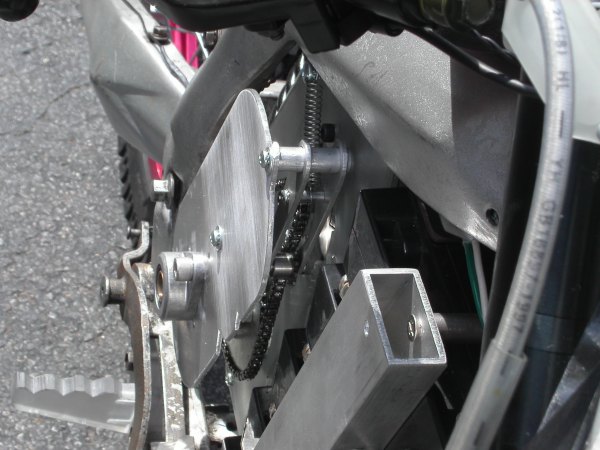
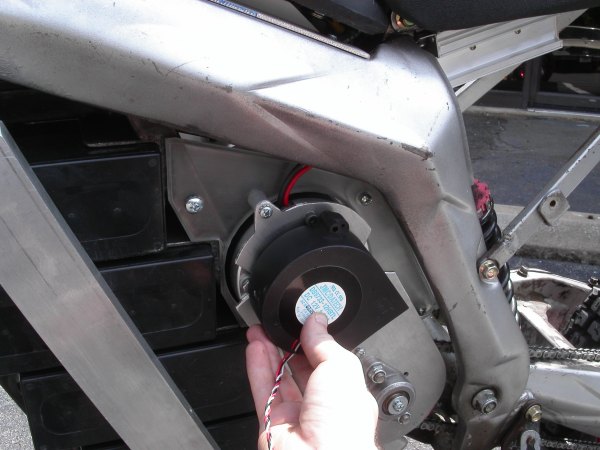
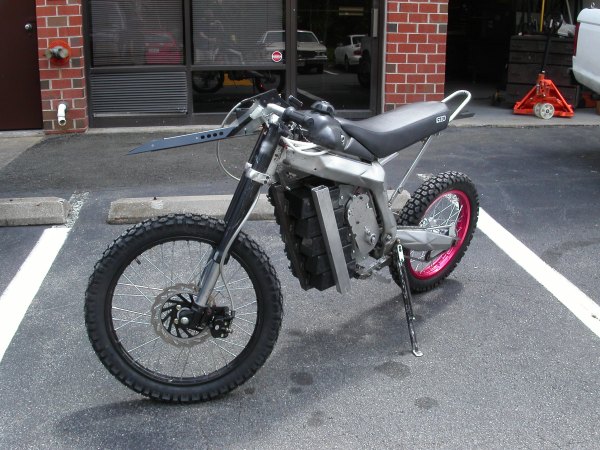
I need to make a mounting plate so I can attach this temperature-controlled blower fan as shown.
It handles really well. I'm actually surprised by how comfortable it is.
Nice. Hope you can get some good cooling with the fan. Maybe slotting the mounting plates would also help.
Spacer plate for the blower fan.
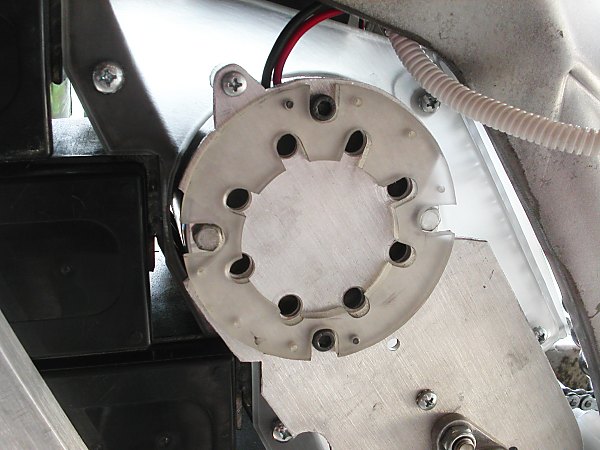
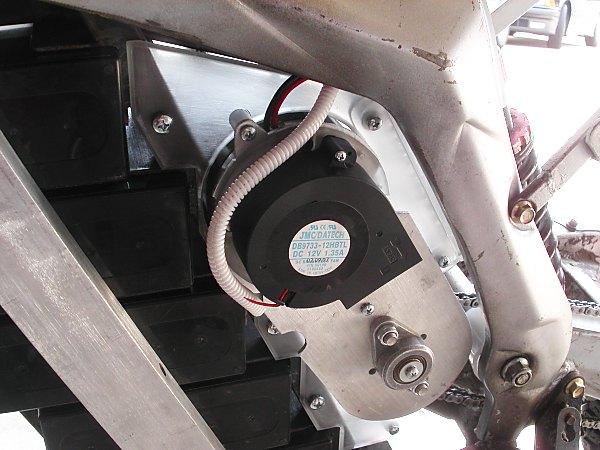
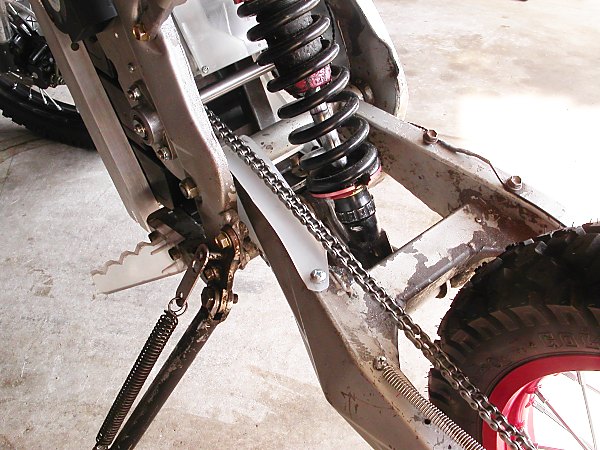
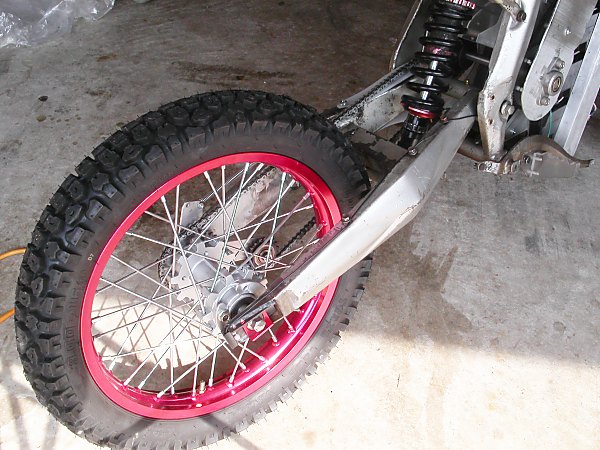
Blower fan installed. Does a fine job of keeping the motor at reasonable temperature levels.
I ended up making a chain pad since I couldn't find a replacement one anywhere.
Rode it 5 miles today. Performs really well.
Next step is to replace the battery pack and controller wiring with a higher wire gauge so I can remove the circuit breaker (or get one with a higher rating).
Awesome job!!
Truly a functional work of art! Excellent job!
John H. Founder of Current Motor Company - opinions on this site belong to me; not to my employer
Remember: " 'lectric for local. diesel for distance" - JTH, Amp Bros || "No Gas.
Good day followed by a rough night.
Replaced all of the battery pack wire with 6awg with Anderson powerpole connectors because the two-pin connectors were starting to melt.
Went for two 8 mile trips today. The motor was overheating a good deal and it got so hot on the trip back that I had to pull over.
I'm not sure what I'm going to do. I'll have to think about ways to add more effective cooling, or try to find an alternate motor.
Here's everything I've done in the past month. I apologize for not being able to take in-progress shots, but my camera took an accidental vacation in China because my boss mistook it for his.
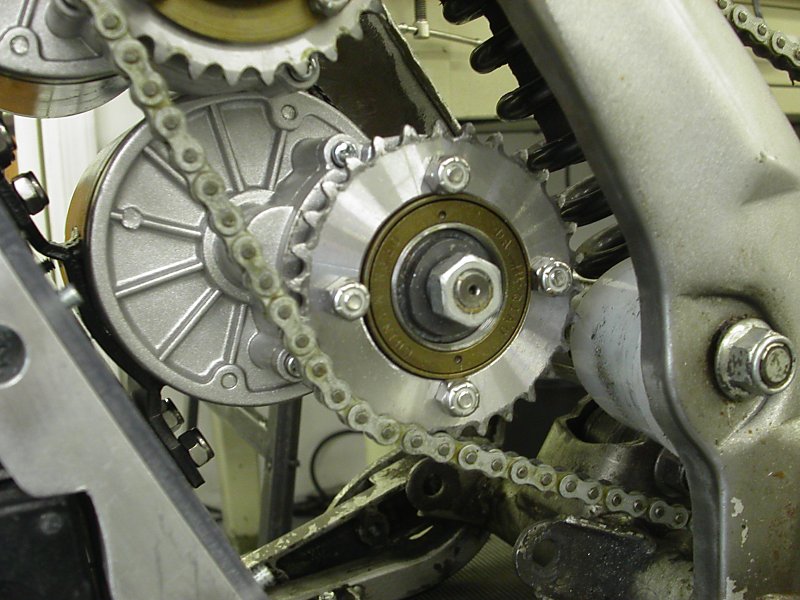
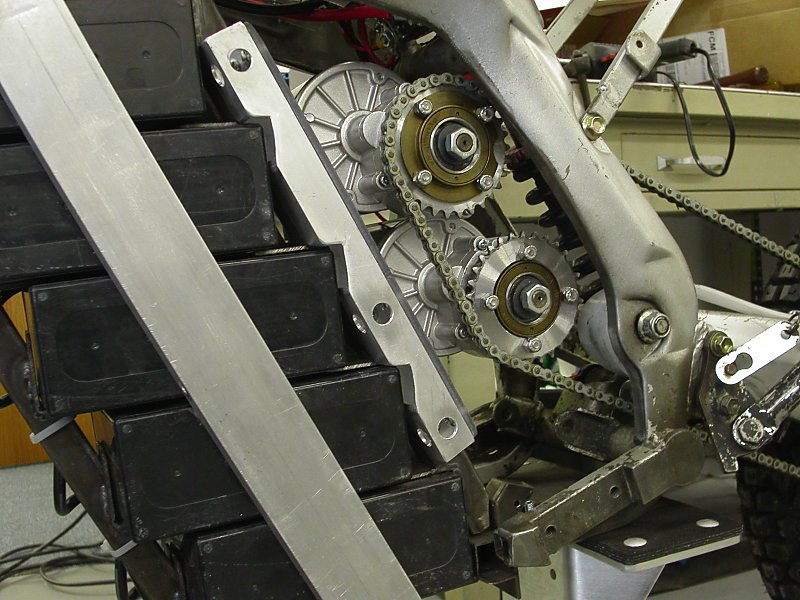
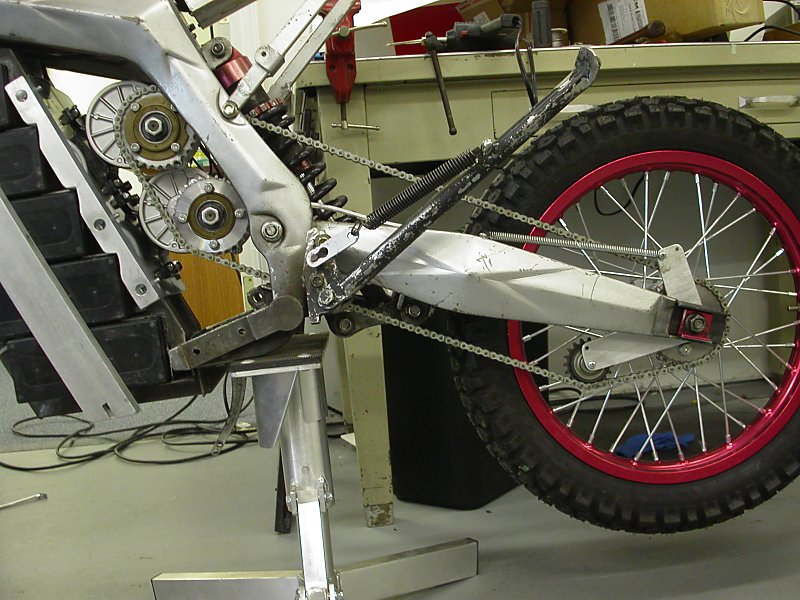
+ I bought a 5/8" ID steel freewheel adapter from Staton Inc.,
+ I used the lathe to bore the ID out to match the motor axle size.
+ The #40 double-D-bore sprocket included with the motor was ground down to make a washer.
+ Washer was then TIG welded onto the freewheel adapter.
+ I drilled the hole pattern into the #35 sprockets, then used a bolt to chuck in the lathe so I could cut out the large center hole.
+ I made a motor-mount plate out of 1/4" polycarbonate, and end brackets out of 1" aluminum square tube.
The sprockets are bolted onto the opposite sides freewheels so I could attach the motors to the motor mount plate at an offset. This allowed me to overlap the gear case of the top motor over the cover of the lower motor.
See below image showing where I had to grind both.
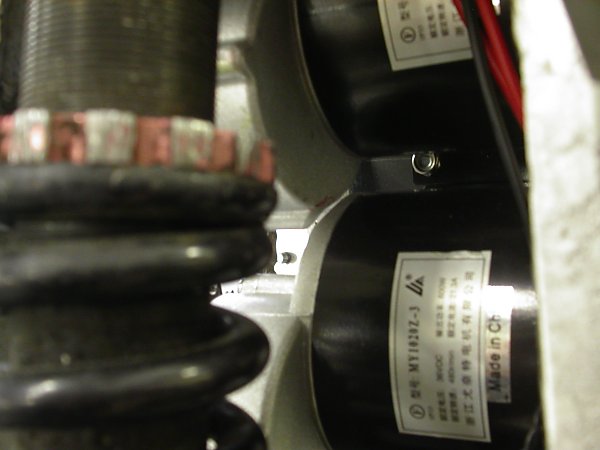
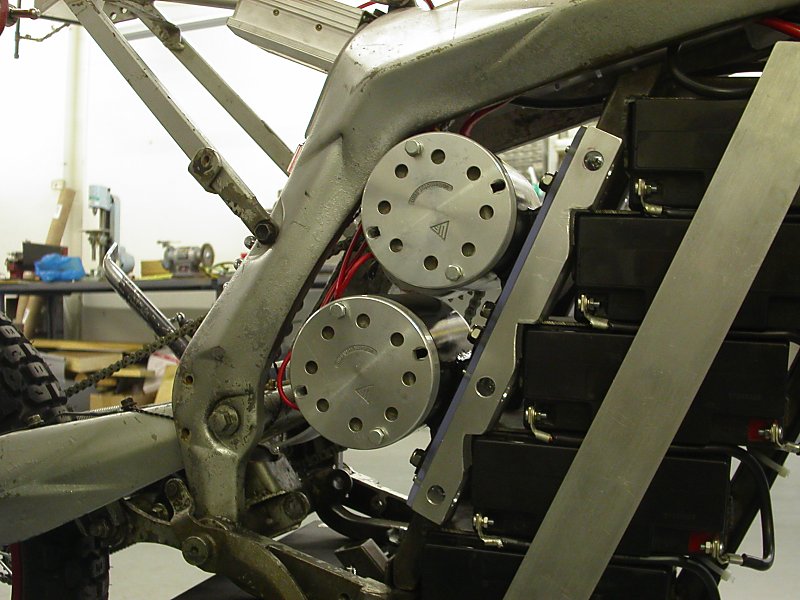
Doing this save me just enough space so that I had more than enough clearance between the frame and the top side of the chain.
I also drilled out and cut square notches in the mounting holes.
I thought I was going to have to offset the brushes 90 degrees to reverse the motors, but it turns out the motors spin the right way around when stock.
Wasted effort on my part, but at least I had the option of reversing them later on.
Left to do
1. Make new aluminum foot pegs. The polycarbonate ones broke when the bike was accidentally tipped over.
2. Make new brake light
3. Make new turn signals (front and back)
4. Record a video for everyone that has been nagging me to
It seems that your energy calculations are incorrect, since one horsepower is 746 watts, a 1.8 horspower requirement means that if the motor were 100% efficient(they are not) a D.C. power of 1,342.8 watts, not 1,000 watts as stated, would be needed to provide this power. (In reality, considering losses in the controller, wiring, and moter efficiency,(mostly lost as heat) actual D.C. power needed to produce 1.8 horsepower of usable enegy is likely to be much closer to 1,700 watts!-Batteries and wiring will need to be sized to handle this, as well as momentary overloads of perhaps 3 times this, when accelerating. Some battery cells do not last as long if not operated in the upright mounting condition, perhaps you may want to check with the manufacturer of your cells, as it seems they would be almost lying on their sides?--Bob
Robert M. Curry
1,000 watts is the constant rating of the previous motor. I was reaching 2,500 watts during acceleration, which the motor was unable to survive. I haven't done any calculations, because I don't have a finished build.
I've already contacted the manufacturer of these batteries and they said that these batteries will work fine in any orientation other than being upside-down. Mounting them sideways will only shorten their life a marginal amount (less than 10%).
What happened? When did the single motor get changed to dual motor?
I know the old motor was overheating, then the blower fan active cooling was added...with mediocre results.
Then suddenly the photos show dual motors. How are you connecting the controller to the dual motors?
BTW, usually overheating motors indicate the transmission is geared too high (I assume the motor is not undersized). Perhaps regearing will help?
The single 1kw motor couldn't survive the 2.5kw peak current draw that was required under acceleration on level ground. I'm switching to a pair of 600watt gear-head motors so that the current load can be divided between them. They won't overheat since they're not individually being overcurrented as much as a single motor would be. This setup will also give me greater low-end torque.
Brushed motors can easily be wired to a controller in parallel.
I've found a solution for linking them together with chain to fix the slipping issue and will be implementing it on Monday.
I'm working on a fake exhaust that is in fact a brake light.
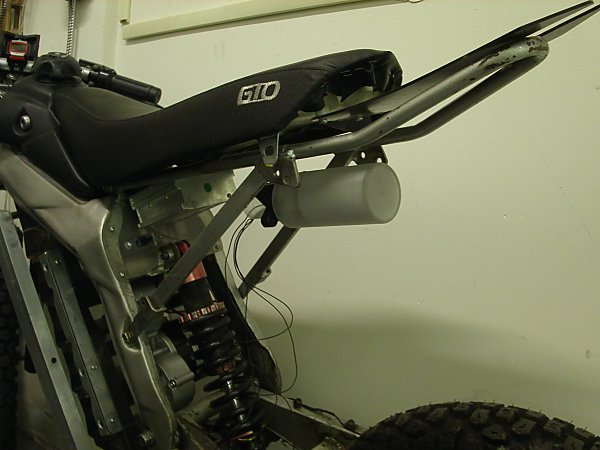
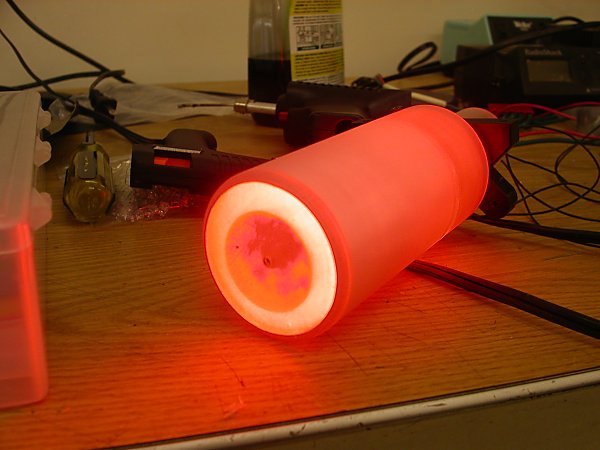
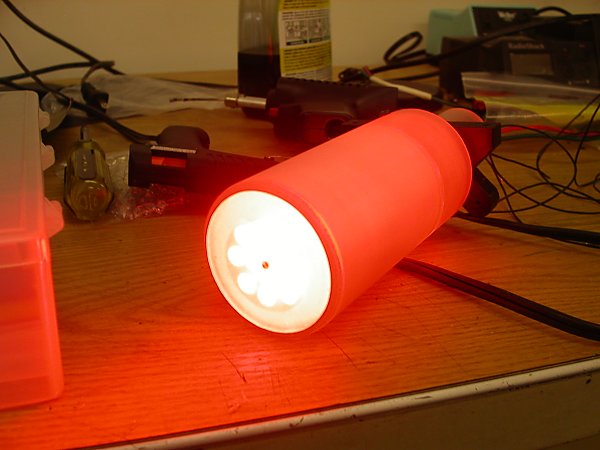
Absolutely amazing project! Congratulations!
Will it be street legal?
The batteries are back in and it's running. I'll record a video sometime soon (have to figure out a camera mount first).
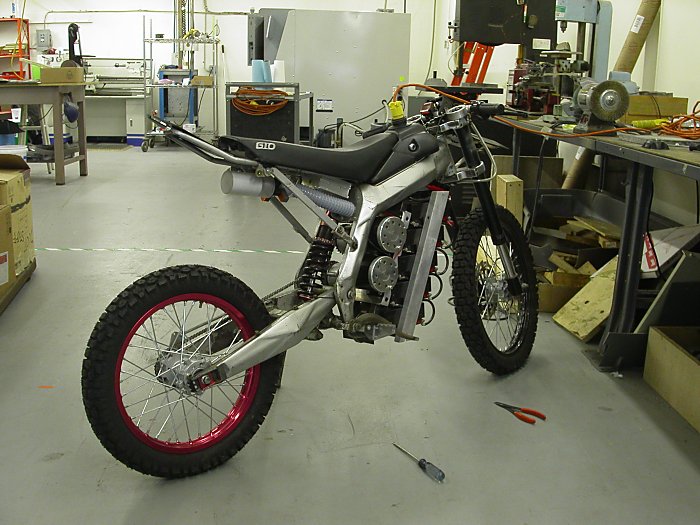
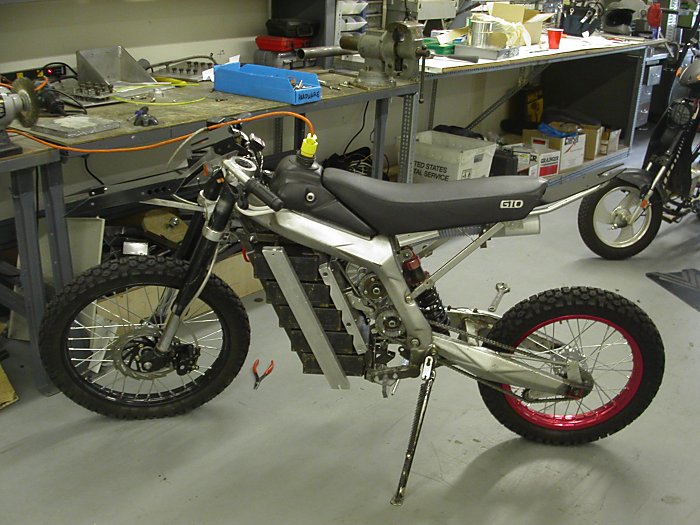
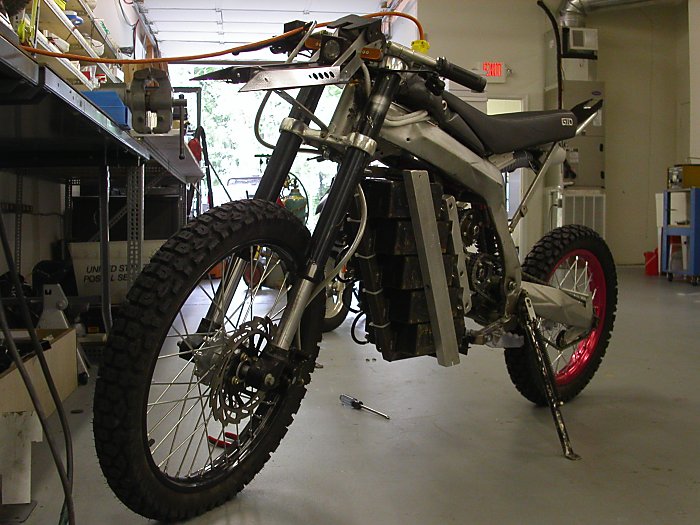
It has A LOT of low-end torque. Climbs hills easily even at 25% throttle.
The motor, gear, and chain drive combination sounds very spacey.
Yes, but will be considered equivalent to a moped according to the DMV code in my state.
Went for a test drive this afternoon. Top speed on level ground is 38MPH.
Not sure what the range is going to be.
I need to add a stronger spring to the drive chain tensioner before I ride it any further.
Great work ! A French off-road bikes manufacturer is making a similar concept.
Scorpa is known by their trial bikes. They have designed a light moped for road use that is easily convertible to a trial bike. It is more expensive 2600€, but are using good parts (specially the battery):
1000W DC 48V Brushless motor and a 16Ah removable Li-Po battery (you can optionally use 2 packs in parallel)
Here it is: eTricks
Upgraded to much heavier springs on the chain tensioners.
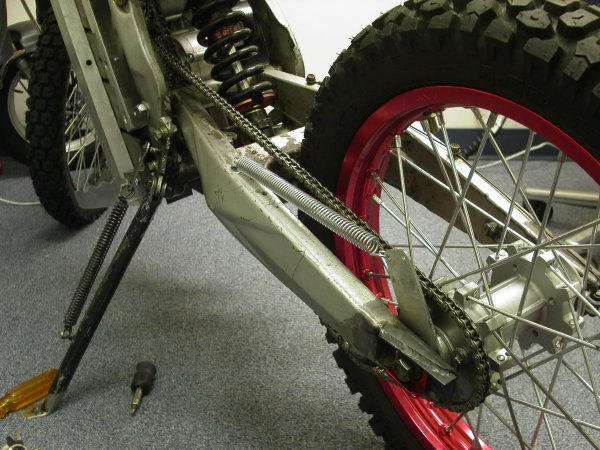
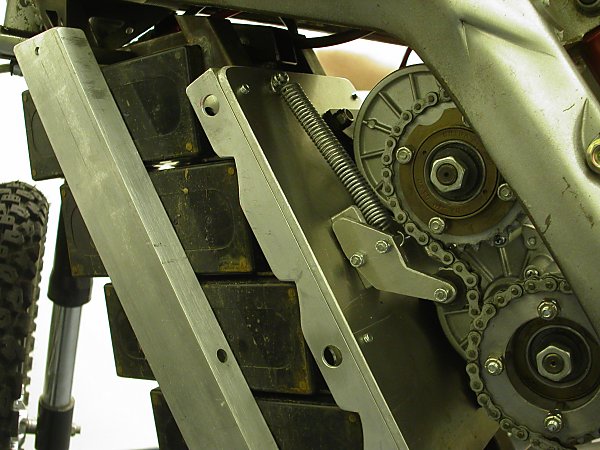

I'm going to install a temperature monitor on one of the motors before I do any further testing. Neither of them were getting anywhere near as hot as the previous motor, but I still want to be able to monitor them.
I'm also probably going to add a fan to the chain guard I will hopefully be making by this weekend.
Bad News, and I need a break from this project.
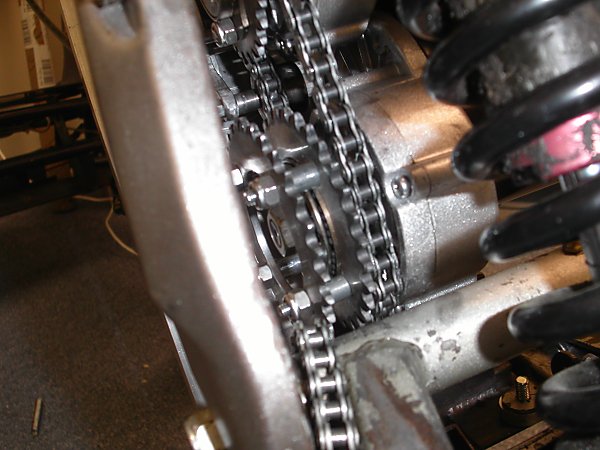
The lower freewheel is destroyed.
I'm going to have to rethink the drive system a little bit. Probably by switching to having just one freewheel, and using static sprockets to link the two motors.
Ouch!
this chain hurts... In my opinion this transmission is too complex..
Two small engines... Are they powerful enough? I'm afraid they aren't.
On the other hand you are wasting too much energy in these chains and gears. Electric power is not meant for this complexity, it allows simplicity...
I suggest you to have a look at the bikes from ttxgp:
http://www.asphaltandrubber.com/racing/team-agni-wins-inaugural-ttxgp/
specially have a look at the video minute 1.40
These bikes work!! And use very simple transmissions... Efficient transmissions...
Have a look at this picture: it's the transmission of a quantya.... it may give you some ideas!
And to this video.. this transmission/engine performs nicely under hard tracks!
You can see more pictures of this special modified quantya here:
http://www.meteopallars.com/solar/YaBB.pl?num=1252070822/all
Best regards,
R
By the way, some time ago I converted with Aleix (yes the Aleix in this forum)an old motorbike:
http://visforvoltage.org/forum/7520-puch-condor-iii-conversion
The engine was directly linked to the rear sprocket. One permanent gear, 70 km/h speed; Superb climbing capacity. No need of any kind of freewheel gear.
While I agree with some of what R says - along the lines of "are two motors better than one?" I very much disagree with his suggestion that you simply copy what else has already been done many times by many people. I applaud your effort and obvious engineering and fabrication skill going into this project. By trying the non-obvious and solving the problems and sharing your efforts in this way you're doing the community a great service. I bet you're having fun along the way.
Keep up the good work! :-)
John H. Founder of Current Motor Company - opinions on this site belong to me; not to my employer
Remember: " 'lectric for local. diesel for distance" - JTH, Amp Bros || "No Gas.
Mmmm maybe I'm not comunicating properly.. I'm talking in terms of energy efficiency, not in terms of personal effort. These complex chains absorb a nice percentage of the battery that simply heats nothing else than metal jointures. I encorauge creativity, of course, but joined with efficiency. There's so few energy inside a battery! EV can't waste it like an oil burner... Sure no need to copy, let's innovate and try to build these two engines mixed into one and inside the wheel... no gears, no transmission... ;-)
Drilled and tapped the small sprockets to M12-1.75. The one on the lower motor will have to be tacked in place to keep it from backing off the thread.
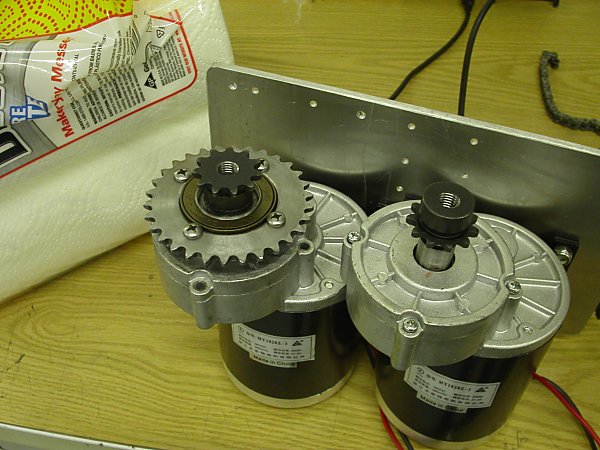
Measured again and then modified the motor-mount plate.
New power train works great.
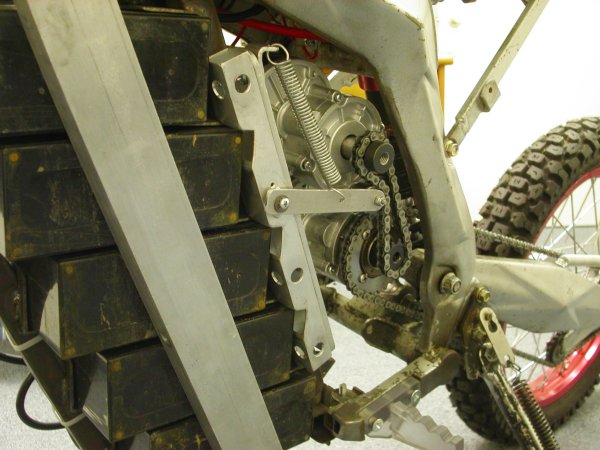
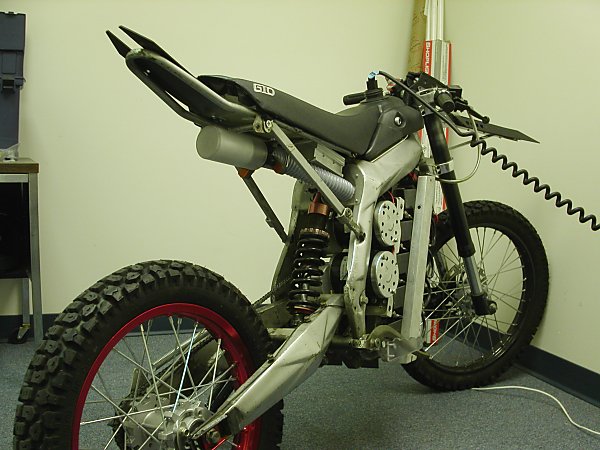
But the bad news is that the motors are still getting very hot at speeds above 20mph.
I feel like I'm out of money and out of ideas. As a last-ditch effort I may try to water-cool the motors, since I already have the supplies to do so. Doing so just unfortunately complicates the bike more than I really wanted to.
Scratch my previous pessimism. After I get the temperature monitor installed I will hook up the battery pack at 48 volts and see if the controller can handle the lower voltage. If it can I would like to do some test runs at that voltage and see if the motors stay a more reasonable temperature.
If the controller doesn't like 48 volts then I'll source a cheap one and do the tests.
I can get the same top speed at 48 volts if I switch the freewheel sprocket to 35 teeth instead of 30. But I need to find out if the voltage drop will resolve the thermal issues.
Being at 48 volts will also make it easier to upgrade to a lithium pack later on.
Remember: HEAT= wasted battery power! Get a single, better motor. An ETEK motor will perform at the voltages and speeds you desire, your existing motors are too low powered.-Bob
Robert M. Curry
I've experienced this issue in many conversions made by people hanging around in Barcelona. They all made the same mistake... You haven't calculated the optimum speed of the wheel to keep the engines efficient, have you?
The engines get hot because they are forced to waste a lot of energy to sustain a hi torque demand. It's like starting in a car with the 7th gear directly, the car won't start. You need to put First gear to start: Just to check if I'm right or wrong, I suggest you try a bigger (really very big) rear chain sprocket in the rear wheel, so the engines will be under less torque pressure. Therefore less energy will be required to sustain the same speed and The engines will be free to "breath". The main drawback is a reduced top speed, but by increasing the energy efficiency you'll increase your range...
If you ever get tired of these toy engines, you can consider buying an Etek RT or similar good engines.
I can't afford a larger motor/controller combination. The point of this project was to build a working vehicle on a budget. What you are recommending would triple or quadruple the total cost of this build.
If I can't get these to work then I'm just going to throw in the towel and be happy with just riding my 50cc moped. I have no interest in using money I don't have to solve a problem that's not critical.
Pages